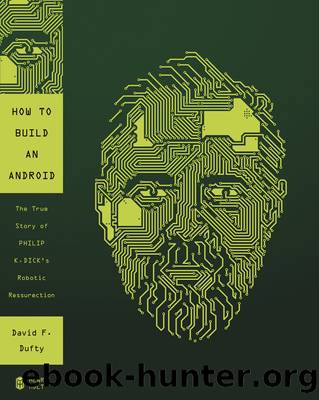How to Build an Android by David F. Dufty

Author:David F. Dufty
Language: eng
Format: epub
Publisher: Henry Holt and Co.
Android Phil before his beard was applied
Grossman asked Hanson about the back of the head. Was he going to cover it up with Frubber skin? Hanson said he would, but other things needed to be done first. He had to put on the beard, eyebrows, and makeup and finish installing the facial motors. Grossman invited Hanson and his girlfriend to stay with him and his wife in Germantown, a quiet outer suburb, east of the city. They had a large house with plenty of spare room, and there was a great Thai restaurant nearby. Evening was approaching and Hanson and Amanda had driven all day, so they left for dinner with Grossman.
* * *
NextFest was due to kick off in less than a week. Time was running out. Hanson and Olney started early the next morning inside Club VALIS in the empty theater, with coffee cups and muffins littered between laptops. They set up the android Phil. His head was mounted on a metal frame that was hidden from view by the body, which Hanson arranged into a human pose, sitting casually on the sofa. The room quickly became a tangle of cords and leads, computers, adapters, and screens. Power cables provided electricity to the motors that acted as Philâs muscles. A series of wires transmitted commands to the muscles from computers that were installed in the corner. Olney had brought several computers into the room. He needed a bank of three to run the basic android setup, which included several applications, operating in parallel, each with a heavy computational load. The facial recognition and tracking software alone required a dedicated machine.
Until now Olney had been flying blind, writing code for an android he had never seen. He had also installed the face recognition, speech synthesizer, and other modules and connected them to the dialogue software in a network of applications to run the android in real time. He had not once had the opportunity to test his programs to see if they would work on the real thing. It could all go wrong, and making mistakes entailed substantial risks. The software could command the motors to do impossible things or things that would break the machinery, such as telling two motors next to each other to pull the skin in opposite directions, causing the Frubber to tear.
The first step was to establish the acceptable range of movement for each motor. This was done by commanding a single motor at a time to move back and forth, until the limits of what that motor could do without damaging the robot were found. Those limits would then be set in the face-control software Olney had written. With this information they could create a map of the face and its mechanical muscles and then start the next step, which was figuring out how the motors could work in unison to produce emotions without ripping the face apart.
Eva, and Hansonâs previous robots before her, had possessed a limited repertoire of expressions. They were
Download
This site does not store any files on its server. We only index and link to content provided by other sites. Please contact the content providers to delete copyright contents if any and email us, we'll remove relevant links or contents immediately.
| Drafting & Mechanical Drawing | Fluid Dynamics |
| Fracture Mechanics | Hydraulics |
| Machinery | Robotics & Automation |
| Tribology | Welding |
Whiskies Galore by Ian Buxton(41938)
Introduction to Aircraft Design (Cambridge Aerospace Series) by John P. Fielding(33092)
Small Unmanned Fixed-wing Aircraft Design by Andrew J. Keane Andras Sobester James P. Scanlan & András Sóbester & James P. Scanlan(32764)
Craft Beer for the Homebrewer by Michael Agnew(18197)
Turbulence by E. J. Noyes(7978)
The Complete Stick Figure Physics Tutorials by Allen Sarah(7338)
Kaplan MCAT General Chemistry Review by Kaplan(6900)
The Thirst by Nesbo Jo(6877)
Bad Blood by John Carreyrou(6583)
Modelling of Convective Heat and Mass Transfer in Rotating Flows by Igor V. Shevchuk(6406)
Learning SQL by Alan Beaulieu(6237)
Weapons of Math Destruction by Cathy O'Neil(6215)
Man-made Catastrophes and Risk Information Concealment by Dmitry Chernov & Didier Sornette(5956)
Digital Minimalism by Cal Newport;(5704)
Life 3.0: Being Human in the Age of Artificial Intelligence by Tegmark Max(5516)
iGen by Jean M. Twenge(5385)
Secrets of Antigravity Propulsion: Tesla, UFOs, and Classified Aerospace Technology by Ph.D. Paul A. Laviolette(5333)
Design of Trajectory Optimization Approach for Space Maneuver Vehicle Skip Entry Problems by Runqi Chai & Al Savvaris & Antonios Tsourdos & Senchun Chai(5037)
Pale Blue Dot by Carl Sagan(4954)
